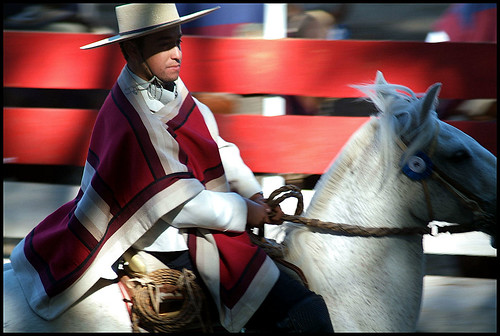The following post is an excerpt from my book Speaking Chileno: A Guide to the Spanish of Chile. Launched in Chile in 2010, this book quickly became a bestseller. Now for the first time it is available outside of Chile in paperback and eBook Kindle.
This is the first of three posts on How To Speak Like a Chilean. Don’t forget to read the next two: 6 Pronunciation Tips to Speak Chilean Spanish and 4 Non-Verbal Chile Spanish Expressions: Gestures To Go Native Chilean.
How To Speak Like a Chilean Part 1 | Chilean Spanish Grammar
Why, you ask, would you want to speak exactly like a Chilean? A few reasons come to mind. The most important and perhaps obvious is to communicate better. Ask a Chilean how much it will cost you to take una guagua to Pucón, and it’s more than slightly possible you may have to explain yourself to the police after being arrested. In Puerto Rico, for example guagua means “bus”, but in Chile it would be a “baby”.
There’s also the challenge involved in learning a culture enough to mimic it, or at least to fit in. It feels quite good when your Spanish is fluent enough that someone doesn’t recognize where you’re from, or that you’re not a native speaker.
Perhaps the best reason is to make people laugh. It’s always entertaining to hear a foreigner use typical slang phrases, words and pronunciation. Just try walking up to your Chilean friends and say “Chucha la Hueá” (pronounced choo-cha la way-ah). You’re gonna get a laugh from someone, if only because they’re not used to a foreigner talking like that (but be careful, that’s not the nicest phrase to go throwing around).
How do you achieve this? Focus on the basics. There are four major components to speaking like a Chilean:
1. Vocabulary
2. Grammar
3. Pronunciation
4. Intonation
In this 3-part series with excerpts taken from the book Speaking Chileno, I will explore the first three mentioned above.
Here are a few samples of Chilean deviations from common Spanish grammar, based on my experiences.
1. en la mañana/tarde/noche
The widespread use of these phrases in Chile beginning with the preposition en led me to believe that this is the correct phrase for “in the morning/afternoon/evening”. I found out several years later only after moving away from Chile that the grammatically correct preposition is por as in por la tarde. You will probably only ever hear en… in Chile.
2. re-
The prefix re- for any word demonstrates “extra” of whatever is said. For example, re-cansado would mean really or extremely tired. The sentence La Claudia tiene un vestido re-fashion would mean that Claudia has an extremely fashionable dress.
3. subir para arriba
Since subir para arriba means “to go up upstairs” it is redundant and therefore grammatically incorrect. Similar phrases are salir para afuera (to leave for outside), entrar para adentro (to enter inside), and bajar para abajo (to go down downstairs) are common yet, since they are redundant, are grammatically incorrect. The correct structure would be either ir arriba as in voy arriba or subir as in él sube.
4. cachai, entendí
Here’s the short version of this one (on advice of the Boredom Police I deleted the more technical description). Most of the time in Chile (and most other Spanish speaking countries) verbs that end in -AR are conjugated using -AS as the ending for the second person singular TU (for instance tú cachas), and -ER and -IR verbs are with -ES (for example tú entiendes or tú sientes). In Chile, you will often hear an -AI or -I ending (as in cachai, entendí or sentí). This is extremely informal and most often used among friends.
Example: René, anda a comprarme un chaleco. ¿Me entendi?… René, ¿me cachai, o no?
Translation: René, head out to buy me a sweater. Got it?…René, you get me or not?
5. –ito
The suffix -ito is extremely common in spoken Chilean and has at least three different uses:
The first use is to understate something, as in the difference between el café está cargado or el café está cargadito. Normally cargadito would mean that the coffee is a little strong, less strong than cargado, but here it actually means that the coffee is really strong, even stronger than cargado.
It may also signify a small amount or portion of something. For instance, dame una cucharadita de los porotos granados, would mean give me a little bit, as in a small portion of the porotos granados.
Third, it communicates affection. As an example, vente mi chanchito y te doy la papa, would be a typical phrase used with your son. You aren’t really saying that your kid’s a little pig. The translation is “Come here my little piglet and I’ll give you your (milk) bottle.”
6. Soy
Normally, the word soy is the first person conjugation for the verb ser and means I am. However, in some instances in spoken Chilean it will mean you. For example, the phrase ¡Soy porfiado! means that you are porfiado instead of what it should mean which is I am porfiado. The best way to pick up on this is to decide if the person is pissed at you for something or not, and from there figure out what they meant.
As always, I would love to receive any other contributions you may run across. Please share your personal experiences below.
Check out these other Chile Spanish Slang Word articles.
Featured photo credit: Huaso from chile by hector melo via flickr
